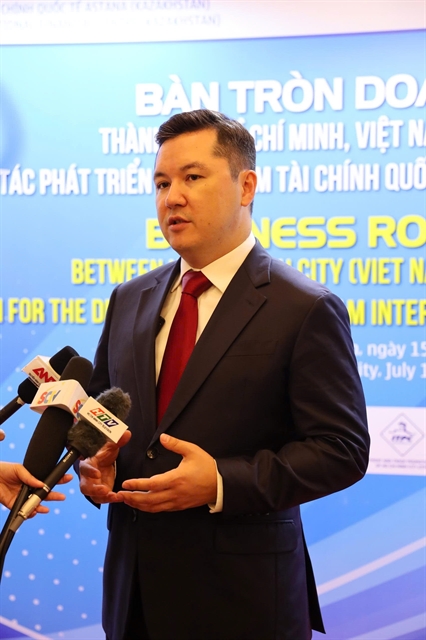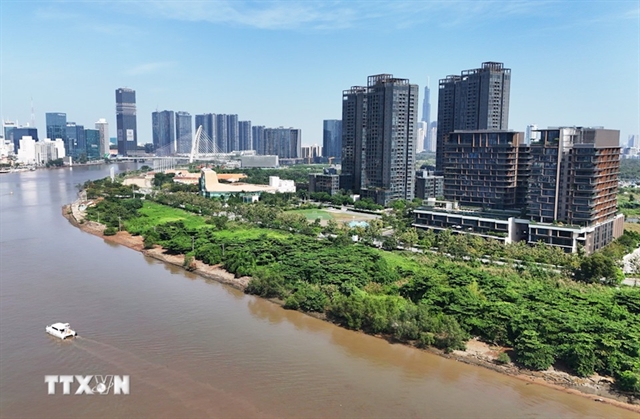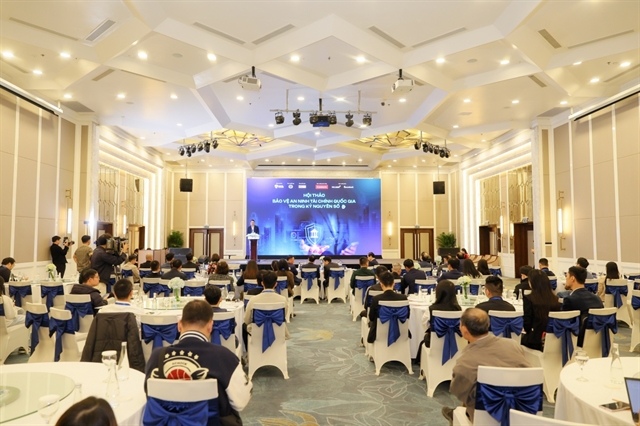 Economy
Economy

 |
| Renat Bekturov, Governor of the Astana International Financial Centre. — Photo courtesy of ITPC |
As HCM City accelerates its plans to develop an international financial centre, Renat Bekturov, Governor of the Astana International Financial Centre (AIFC), the top financial hub in Eastern Europe and Central Asia according to the Global Financial Centres Index, shared with the media his insights on the city's competitive strengths, the AIFC’s development journey, and prospects for bilateral cooperation during a recent visit.
What do you think are HCM City’s key advantages, and what potential does it have to become a Southeast Asia financial hub?
I believe Việt Nam’s economy is highly attractive. It is already one of the fastest-growing economies in the world. What’s even more exciting is that its full potential remains untapped. While the country’s GDP is approaching US$500 billion, its GDP per capita still has significant room for growth. So first and foremost, Việt Nam already has a strong and promising economy.
HCM City, in particular, is a standout. Following its recent merger with two provinces, the city now has a population of around 14 million and contributes around 30 per cent of the country’s GDP. This makes it a major economic and business powerhouse. Walking through the city, I saw international financial institutions like JP Morgan and other global banks, reflecting the city’s growing financial integration.
Moreover, HCM City has a vibrant business environment and a thriving tech sector, both of which are important foundations for developing an international financial centre (IFC). One of the key benefits of establishing an IFC is improving capital flow. But for that to happen, a robust, transparent regulatory framework must be in place. Once established, this framework will encourage capital inflows that can further drive economic development, ultimately benefiting the local people.
In short, HCM City is already Việt Nam’s business hub and has great potential to become one of the leading financial centres in Southeast Asia.
What factors contributed to the AIFC’s success as a financial centre in Eastern Europe and Central Asia?
Financial centres operate under various models—some based on common law, others on civil law. What truly matters is creating the right environment for businesses to thrive. At the AIFC, our success rests on three key pillars.
First is our independent legal system, which is based on common law, though Kazakhstan is a civil law country. This was a deliberate decision, as many international businesses are familiar with operating under common law jurisdictions like the UK, the US, Hong Kong, and Singapore. Familiarity builds confidence when entering new markets.
Second is our independent dispute resolution system, which includes an international court and an arbitration centre. I often compare this to the safety net in a circus: before a performer makes a daring leap, they need assurance that there’s something to catch them if things go wrong. Similarly, investors hope never to face disputes, but if they do, they want assurance that these issues will be resolved in an impartial and independent manner.
Third, and perhaps most crucial, is the support from the country’s top leadership. In Kazakhstan, the president chairs the AIFC Management Council and appoints its governor and actively promotes the centre on the global stage. This top-level backing sends a powerful signal to international investors that the government is fully committed, which is essential for building trust and confidence.
 |
| A corner of Thủ Thiêm urban area, which will be part of the planned international financial centre in HCM City.— VNA/VNS Photo |
How can HCM City attract investments and global financial institutions?
For both our countries to grow our economies, we need capital and investment, particularly from international sources. That was the driving force behind the creation of the AIFC: to establish an environment that attracts global investors.
A key requirement is a transparent and independent legal system, along with regulatory frameworks aligned with international standards.
There are internationally accepted standards that help businesses manage risks and operate with confidence, such as the Financial Action Task Force guidelines on anti-money laundering and counter-terrorism financing.
Equally important is ensuring smooth capital flows. When investors commit funds and earn returns, they expect to repatriate their profits without undue barriers. Therefore, there should be no unnecessary barriers to capital inflows or outflows.
Compliance with capital controls and tax regulations is also an important factor to consider when creating an environment conducive to global investment.
What is the potential for cooperation between the AIFC and HCM City?
We see great potential for collaboration between the AIFC and HCM City. Drawing from our experience in building a globally regulated, world-class financial centre, we are ready to share not only our successes but also the lessons and challenges we encountered, to help accelerate the development of HCM City’s financial centre into one of the region’s most dynamic hubs.
We have already had several high-level and productive meetings with the city’s authorities. We’ve put forward a number of proposals and are eager to share our expertise and offer consultation on how to establish and operate a successful financial centre. If the leadership of HCM City and Việt Nam is open to deeper engagement, we can become a strategic partner.
Earlier this year, when His Excellency General Secretary Tô Lâm visited Kazakhstan, the relationship between our two countries was elevated to a strategic level. We are keen to build on that momentum and support HCM City in building the international financial centre so that not only can our businesses come to Việt Nam and invest, but Vietnamese businesses can also explore opportunities in Kazakhstan.
In fact, three Vietnamese companies are already registered at the AIFC: Vietjet, which acquired an airline in Kazakhstan; Elisoft, an IT firm; and Coteccons, a leading construction company.
Similarly, Kazakh companies are operating in Việt Nam. A notable example is Kusto Group, a major real estate developer that has been present in the country for 18 years and recently completed the Diamond Island project in HCM City.
These examples clearly demonstrate the potential for strong, two-way economic ties between our financial centres and countries. — VNS




